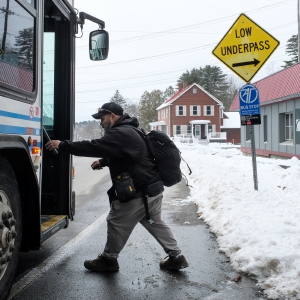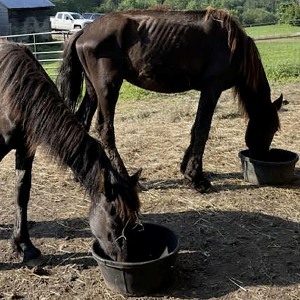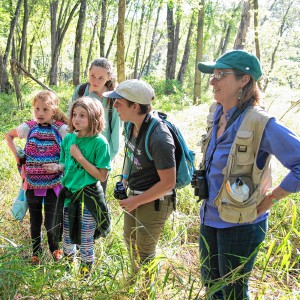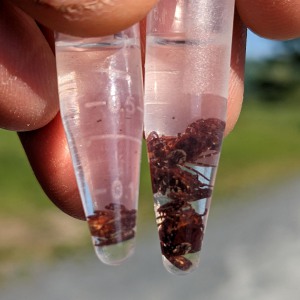Eyes on the Land: Years of Observation Shape a Corinth Farm
| Published: 05-15-2018 10:00 PM |
May 2
I
Warmer temperatures and rains over the past several days have finally brought out the palest lichen-green leaves along the ridge, and a steadily deepening green on our pastures, lower down. Then on April 30, we woke to a blanket of snow. I knew it wouldn’t last long, but for one final day I pulled on a wool jacket and wool hat, and stepped into winter boots as I headed out the door with the dogs to do chores.
These days we keep a small flock of laying hens, two pigs and 12 Jersey and Jersey-Milking Devon cows and calves. Among them is one mature bull and one “apprentice,” two steers we are raising for beef, two young calves and six milkers, four currently milking. I milk by hand, and bring the milk to our small dairy we call the Three Cow Creamery, after its founding matrons, Bess, Rosemary and Blossom. This is a licensed dairy we operate in a cheese room we lease from Sarah and Joe Nolin at Hurricane Ridge Farm, just a mile from home. There I make traditional English-style hard cheeses, mainly Stilton and Cheshire, in small batches, two or three times a week. The cheeses are sold year-round, directly from the cheese room, and at the Norwich Farmers Market.
My two sons, Silas, 19, and Sam, 21, grew up here and are involved in all aspects of the farm. Ours is an off-grid, wood-heated house and wood-fired kitchen. Sam maintains our solar system, and Silas keeps an eye on the wood supply for the stove that cooks our food and heats our house. Between off-farm jobs, they help me maintain the tractor and hay equipment, put up about 2,000 bales of hay in June and July, repair and build fencing, move animals, help pack up for farmers market, even occasionally flip cheeses. Perhaps wisely, they have opted not to learn to milk cows … not yet, anyway. But this is probably good, as it frees them up to mow pastures, something we still do a lot of at this early stage of reclaiming overgrown pasture.
As cheesemakers, we naturally seek to nurture the health of our herd, which is strictly grass- and hay-fed. So our top farming priority is to nourish the quality of the pasture forages, and the health of the soils beneath them. We observe the condition of our garden vegetables, and of the cows and other animals closely all through the year. But it is in the pastures and their soils where we really take stock of how effectively we are taking care of the land, and how much we can fairly expect of our livestock.
Restoring pasture is an ongoing endeavor here, and has been since I came to live here in the late 1980s. By that time, noticeably less pasture remained open than when I first came to the land with my father in 1975, shortly after he purchased it.
That is a day I will always remember.
Article continues after...
Yesterday's Most Read Articles
 Upper Valley winter shelters kept dozens warm and dry
Upper Valley winter shelters kept dozens warm and dry
 Former principal of South Royalton School released from prison
Former principal of South Royalton School released from prison
 Owner of Friesian horse facility ordered to pay care costs for seized animals
Owner of Friesian horse facility ordered to pay care costs for seized animals
It was winter, and my Dad and brother and I skied far back through the grown-up old fields and up along the shoulders of Hurricane Ridge. Late in the afternoon, as we headed back toward the car — nearly a mile away, as there was no maintained road accessing the property then — I broke the tip off one of my wooden skis, trying to descend a steep, rocky pitch. Thus ensued a long, painstakingly slow return, punctuated by regular face-plants in the snow, through the woods and openings we had so smoothly crossed just hours before.
My dad went along patiently with me, and I have always had the sense he was secretly pleased that, thanks to my minor mishap, I may have gotten a taste for just how big, varied and wild this land was. I was 11 then, and fairly small, and I did indeed have just that experience.
In fact, I never have lost a quiet sense of awe at the steep cliffs on Hurricane Ridge, stark in winter, and bedecked with wild ginger, cohosh, Dutchman’s breeches and hepatica just now, the dense darkness of the spruce and fir forests down close along Meadow Brook, the giant hemlocks leaning out over the brook from atop nearly vertical banks that rise 30 to 60 feet above the water below, and the liveliness of the brook itself, sometimes peaceful, at others roaring.
When I returned to live here in 1987, just before my final year of college, my perspective was slightly different, and as I looked around, I found I kept instinctively looking for traces of the old farm I knew several families had built and worked here, from at least the 1860s until the 1930s. Nothing at all remained of the original house, outbuildings and at least two old barns, and their locations were so overgrown they were almost invisible.
It was difficult to get a sense of how the farm had been situated in relation to the land. But the old foundations, even lost as they were under great tangles of young locust, maple and black cherry trees, offered tantalizing clues, as did the stone walls that still defined old pasture edges and eased back into the woods. My father, who had always hoped to live here, had died the year before, and left me with a real love for this place, which gradually took the form of a resolve to live here, to make working with this land a part of how I would make my living, and getting to know it a part of how I would spend my days.
It seems to me now, looking back over the first 30 years here, that work with the land has unfolded in two stages, so far. The farm comprises 180 mostly forested acres that slope up from Meadow Brook, which forms our southern boundary, toward Hurricane Ridge. We now have a little over 15 acres of productive pasture, and another 10 acres of brushier land we are gradually clearing. But in 1987 there were no more than three or four partly open acres.
In our first, decade-long campaign, my then-husband and I undertook to clear away countless large “pasture pines,” the stunted, twisted, heavily branched or “bully” white pines that quickly take over abandoned pasture, particularly where the soils are overgrazed, thin and acidic, as they were here. With loppers, chainsaws and a small farm tractor and rotary mower, or “brush hog,” we also tackled acres of thriving juniper bushes, sometimes 20 feet across with stumps 8 inches in diameter. Many of these withstood two or three years of being mown before eventually subsiding.
During our second full year on the land, we bought a small, but mighty young work horse named Mike. With his help we pulled out enough of the better pine and spruce to frame and sheath a small house, and to build the first farm structure, a modest, south-facing shed for horses. A friend of one of our first neighbors in Corinth brought his portable sawmill to the log landing out in our new clearing, set it up late in the fall, and gamely skied the half mile in to operate it for much of that winter, milling into boards and timbers the trees that Mike drew out of the woods. Mike quickly earned his place in my heart as the very backbone of this farm, as it came back into being, and he never lost it. The following year we purchased a second horse, an old hand named Bill.
With this steady team to mow and rake, and our old tractor to ted and bale, during the next several years we made 1,500 to 3,000 bales of hay each summer on nearby fields, some leased and others generously shared. In fall and winter we logged with the horses intermittently, shipping softwoods that had grown up decently tall and straight around the field edges, as well as high quality hardwood saw logs from deeper in the woods. In 1993, we built a small house on a new foundation not far from the old farmsite, and over the next several years we slowly cleared another 8 acres of former pasture.
The second stage of pasture renovation took shape before our eyes as we brought first one family milk-cow to the land in 1998, and soon thereafter a second cow. With the cows came a surprisingly different set of fencing and grazing requirements, a very different kind of interaction with the pastures and their soils and really an entirely different agricultural frame of reference than what we had in mind after 10 years of working with horses. For all they accomplish in the fields and in the woods, even workhorses who earn their keep take a toll on the ground. At 1,600 to 1,800 pounds apiece, and often shod with rough borium on the soles of their steel shoes to prevent slipping on winter ice or summer hay while they are working, horses tear the sod, especially on thin soils and sloping fields. They can also compact the ground badly if kept too long in one area. And with their sharp upper and lower incisors (cows have only lower incisors) they can scissor grasses down to within a half- or quarter-inch of the ground, doing lasting damage to the plants and the soil.
Cows on the other hand, move more gently over fragile ground, so long as there aren’t too many of them in too small or too wet an area. Because they tear the grass instead of cutting it, they rarely graze pasture plants lower than two inches, leaving them much more able to regrow. We kept cows only a short time before we noticed a change in the pastures, which were a bit lusher and felt springier to walk over.
We had by this time relegated the horses to more marginal pasture areas, which they seemed to enjoy, as they love to browse young maple and ash, and enjoy the thick cover of copses of trees. Being maintained year-round on rations of hay and small quantities of grain, they also did not require access to our best grass. What little there was of good grazing we turned over to the cows. As I observed the positive changes in the pastures, even without any real grazing management, the possibility of keeping a small herd of cows as a way to improve the land was sown in my mind.
Of course the fundamental difference cows invite us to consider in relation to soils and pasture management is that, unlike horses — at least in this country — what they eat, they in turn transform into various kinds of food for us. Insofar as the adage “you are what you eat” resonated, it suddenly seemed reasonable to start looking more closely at what our cows were eating. As I made butter and yogurt and some pretty down-home cheeses in those early days, and as I offered this food to my young sons, I started thinking about how the quality and flavor of the milk and what I made from it changed throughout the year, depending upon what the cows ate.
As a more practiced cheesemaker, I have become even more interested to know what my cows are eating, and which plants and especially herbs they favor. What kind of pastures and underlying soils thrive even as they are grazed? Which support the most vigorous cows and calves? Which result in the most delicious milk, the most distinctive homemade starter cultures, the tastiest cheese?
These are the thoughts and questions that run through my mind as I set out fencing all year. I am constantly looking to see what new grasses and clovers are gaining a foothold as the pH and the tilth of the soil increases, and peering into hedgerows and around rocks to see what the cows are finding. As I make hay in summer, I regularly jump off the tractor to examine and identify the plants, and finally as I feed out the hay in winter, I study the sections as I separate them, and observe the cows to see what they seek out, or leave behind. Even now, when I can barely see what's twining out from under last fall’s dead leaves, I am watching, nearly spellbound, to see what last year's careful grazing, and this year's hopeful work might offer up.
We began practicing rotational grazing about 10 years ago, and now use portable temporary fencing to move first the cows, in one or two groups, then the two pigs, and finally the chickens across about eight acres of pasture. Rotations begin around May 15, and continue until about Nov. 1 to the 15th — weather depending. Paddock sizes vary depending upon the quality of the part of the pasture we are fencing. Farther out in our back pastures, it is really only feasible to keep the cows, but there they also move across the field in rotations. The cows and pigs are moved onto fresh pasture every two days, and sometimes once a day. This is labor intensive, or at least time intensive, because I insist that the animals always have access to trees or tall scrub, for shade and for scratching on, and because they so obviously enjoy it. So, with my reels of fencing in hand, I wend my way among the trees. But if it takes a long time, pasturing the animals this way has proved to be greatly rewarding.
I have spread very little seed, but a great deal of grass has come into the pastures, mostly the highly palatable orchard grass and also clover and crown vetch. Some seeds come in with the hay. But the vast majority of the new growth, which emerges in all corners of the pastures where the animals have grazed and left behind their manure, and many where they have not been fed hay at all, suggests that there are a great many seeds lying dormant, just waiting for the right soil conditions to develop. We do sow some clover, which, as a nitrogen fixing plant, helps the neighboring grasses to thrive. But mainly we walk, and fence, and watch and wait, and this seems to work well on these old fields.
Ten years ago the predominant species in the pastures were lichen, wild strawberries, cinquefoil and a few different wiry fescue and bent grasses. Now that’s acid soil! Sections of pasture are still like that, also dotted with wild raspberries, but I respect these areas, having watched my milk cows at certain times of the year make a beeline for these humble plants, and nibble them with care but also evident delight.
For the most part though, a diverse mixture of orchard grass, white clover, some red clover, timothy and fescues now predominates, along with a healthy population of plantain, dandelion, and chickweed, all highly desirable herbs, whether you have four hooves, or 10 toes. Where we used to begin feeding a full ration of hay to the cows around the 1st of October, we now begin a month later.
Almost every acre of pasture on this farm is side-hill, susceptible to run-off and soil erosion. But over the past 10 years of sustained grazing management, the soils have become much more absorbent, and at the same time much more resilient in the face of late summer drought. Last month I could easily see the improvement; where I often used to watch spring rains trickling down the slope of the pastures and into our driveway, I watched this spring as they seeped into the thicker plant growth and more porous earth beneath. Though we’d all like to see some more sun and feel some warmth, at this point, I am also thinking ahead to haying and late summer grazing, and so I am delighted that the rain and snow that are still falling, are soaking into our pastures.
While the established pastures become more vigorous, we are at work opening up more grazing land. Leaving plenty of young trees, primarily maples, for the songbirds, and for the cows and pigs to shelter under and scratch on, we cut out the scrappy black cherry trees and saplings, taking what we need for warm-weather cook-stove wood. Carefully we work back toward the old stone walls and fence lines that are our clues to how the land was used by the farmers who lived here over the previous 100 years and more.
What these old stone walls, fence lines and foundations reveal is that the people who lived and worked here paid attention to the lay of the land. Their pastures kept to the gentler gradients and the most protected, southeast-facing slopes. Their walls skirted some wet areas, and if they also enclose some others now, I watch to see signs of where streams may have shifted, and terrain changed, across the decades.
The old house and barn foundations, for their part, though they were not all built at the same time, nestle together at the northwestern close of a southeast facing bowl of land opening out below Hurricane Ridge, with access to the old town road and a nearby, 16-foot-deep stone well that bells out from 2 to almost 4 feet at its base. The foundations of the two bank barns bespeak buildings that once presented their long side walls to the sun, and fit comfortably into the sloping land.
Working here over the years, with horses and with my sons, has rooted in me a deep and abiding interest in learning what are the best scale and kind of farming for this piece of land that I have loved a long time, and am still coming to know. Part of that interest is an intense curiosity about things I was unable to learn from the property deeds or from neighbors, but might eventually learn from the land itself. What grew here? Who grazed here? How many of them? How large were the pastures? How did they fit into the lay of the land?
We ask ourselves these questions as we work here. We adjust our herd numbers, and where we focus our energies, as the land suggests, and according to variations in the growing season and weather patterns, improvements in our pastures, and as our market demands evolve and my sons’ and my own off-farm work schedules shift.
Our frame of reference remains the farm itself, its acreage, its topography and its soils. We did not set out with an abstract idea of a particular sort of farm. Instead we have nurtured something small, but integrated, that has gradually grown out of this ground, and out of the patterns we have noticed, across the year, connecting the different kinds of animals to this land and its plants, to each other and to us. As we plan and work, we keep respectfully in mind the history of this farm, as shadowy as parts of it are to us: its wildness, its fragile but promising soils, and its limits.
Liz Guenther lives and farms in Corinth with her sons Sam and Silas.
]]>

 JAG Productions announces closure, citing ‘crisis facing the arts’
JAG Productions announces closure, citing ‘crisis facing the arts’ How a hurricane and a cardinal launched a UVM professor on a new career path
How a hurricane and a cardinal launched a UVM professor on a new career path Out & About: Vermont Center for Ecostudies continues Backyard Tick Project
Out & About: Vermont Center for Ecostudies continues Backyard Tick Project
